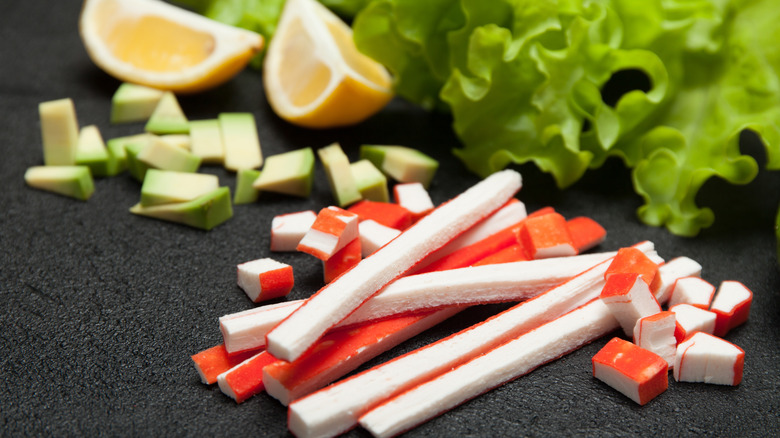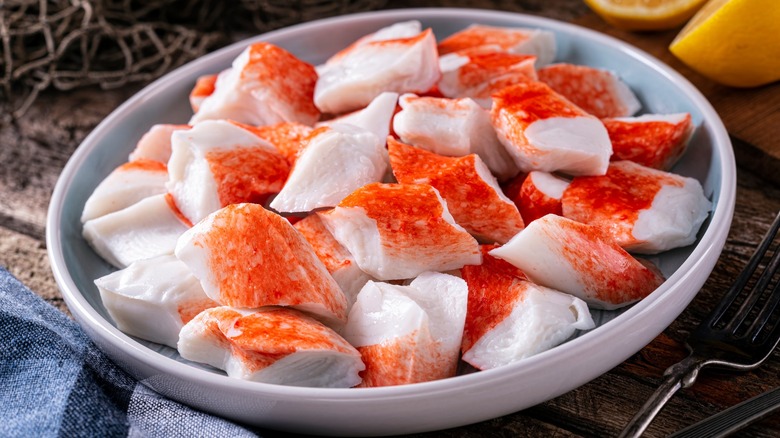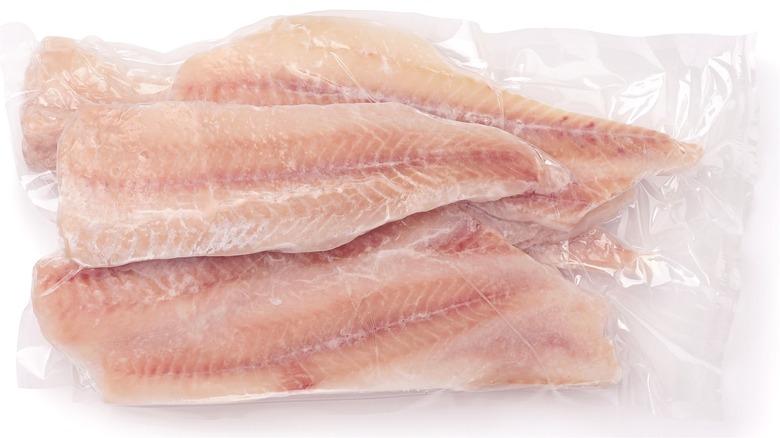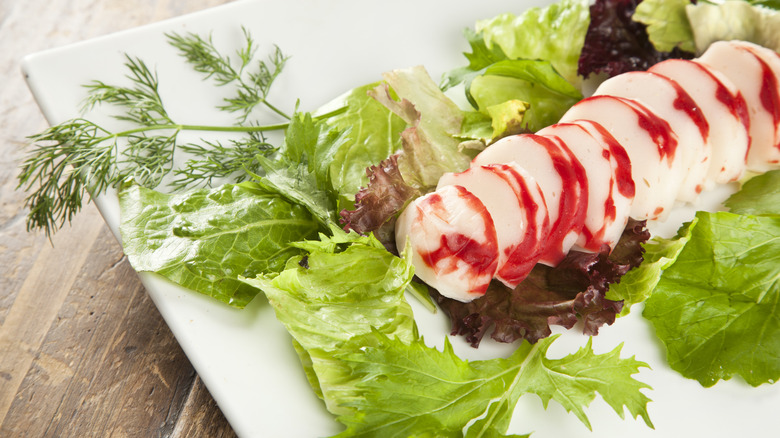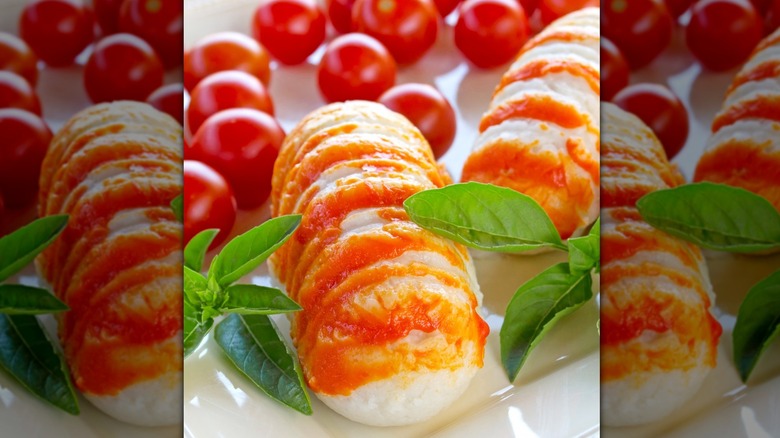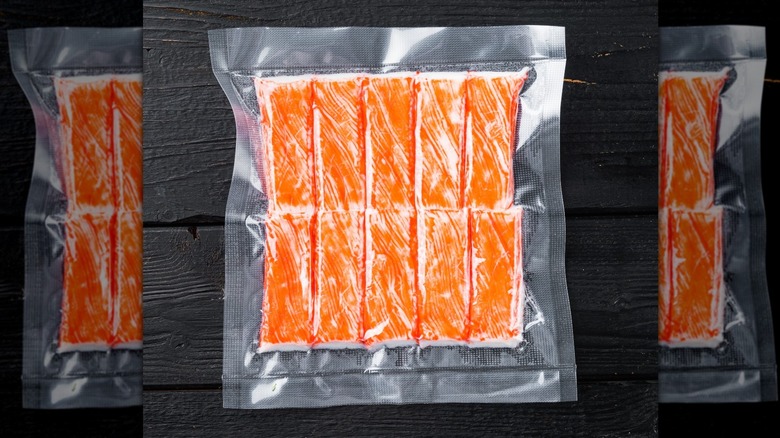What Is Imitation Lobster?
Lobster is a luxurious dish usually reserved for special occasions. The flavor of the tender meat, when elevated with some lemon or garlic, is one you'll want to savor every day. The catch, however, is that lobster comes with a hefty price tag. Even skipping the restaurants and cooking it at home doesn't make much of a difference, as fresh lobster is quite expensive, especially if you don't live near the coast.
Securing the raw seafood is only one half of the equation. Before you can even attempt any lobster recipes, there's one more hurdle to jump with live lobsters: getting the meat out. Preparing the lobster to harvest the succulent flesh could be stressful if it's your first time.
Thankfully, there's an easy way to get around these problems. With imitation lobster, you don't have to break the bank to enjoy an elite seafood dish. Plus, it reduces the physical labor and time spent cooking. Curious to know what imitation lobster is? Keep reading to learn all the juicy details about this remarkable product. The following sections also dive into how best to prepare it, its nutrient profile, and how it compares to the real thing.
What is imitation lobster?
Imitation lobster is a kind of processed seafood made to mimic the taste and texture of real lobster. This is not the same as plant-based or vegan lobster substitutes. Although this product isn't genuine lobster, it qualifies as seafood, as it typically contains a mix of various kinds of white fish, like wild Alaskan pollock.
The base ingredient in imitation lobster is surimi. This is a type of minced meat or fish product first made in Japan roughly 900 years ago. It was a way at the time to get as much flesh from fish containing lots of bones. Traditionally, surimi is used as a single ingredient in Asian dishes like stews or salads, and not as a substitute.
In the 1960s, the process of making surimi evolved when a Japanese chef found that adding sugar could help prolong its shelf life. Following this discovery, surimi became a familiar item in the food industry, as a substitute for more expensive seafood. Imitation lobster isn't the only thing surimi is used in. It's also used to make imitation crab meat.
How is imitation lobster made?
Making surimi begins with picking out the right fish. Generally, cheap white fish like Alaskan pollock is used, but others may also be used. Once the fish has been harvested, it gets processed almost immediately, as frozen fish isn't typically used in this procedure. First, the fish bones, skin, and guts are taken out, leaving the fleshy muscle behind. Then, it's washed multiple times to remove as much fat as possible.
The thoroughly cleaned fish muscle is crushed into a paste and treated with salt. This produces a thick, colorless, odorless gel: raw surimi. The next phase of processing is where the magic happens. You'd be surprised to learn that imitation lobster contains just a bit of real lobster flesh, usually about 17%, but some brands barely add up to 2%. Some shell-based flavorings may also be added to give it an authentic flavor.
Getting the product to look and taste exactly like a real lobster is the goal of this process. Therefore, the manufacturers include food coloring, salt, and low-calorie sweeteners. Polyphosphate preservatives that help maintain the integrity of the product even when stored for a long time are added as well. Additional ingredients such as starches and egg whites also go into the surimi paste.
Imitation lobster vs. imitation crab
Imitation lobster and imitation crab are similar since they're made from the same seafood paste called surimi. The difference comes in terms of the additives. These give each imitation seafood meat a distinct flavor. Similar to how imitation lobster is made with some lobster meat, imitation crab is often made with some real crab. Crab shell flavorings are also added to reinforce the crab flavor.
However, some brands also include crab extracts in their imitation lobster. This helps to provide flavor complexity in the surimi. Both products contain stabilizers like sorbitol to maintain consistency even when frozen.
Price-wise, imitation crab and imitation lobster are far more affordable than real lobsters or crabs. These surimi products come fully cooked, so they only need minimal heat during preparation to avoid overcooking and altering the texture. Plus, they can be stored similarly to each other; both can be refrigerated for a few days, or frozen for a few months.
What does imitation lobster taste like?
Want to know a secret? If you've ever had lobster dishes in a restaurant, you've probably eaten imitation lobster. According to Today, a survey of 28 restaurants conducted by Inside Edition found that 35% of lobster dishes contained fish substitutes. If you're surprised by this statistic, it's because of how well imitation lobster mimics the real thing.
Unless you're a seafood expert, you'll have a hard time detecting the presence of imitation lobster in your meal by taste alone. Despite being such a heavily processed food, it doesn't have a fake taste. Instead, imitation lobster has the same sweet, salty, and fishy taste as fresh ones. And although it's made from fish, you won't get a heavy fishy smell from this product too. Texture-wise, imitation lobster isn't too far off, either. It's chewy yet soft, so it doesn't feel like you're biting rubber.
The only noteworthy difference is that imitation lobster has no varied flavor profile or texture. Every piece you put in your mouth tastes and feels exactly like the previous lump. On the flip side, the flavor of genuine lobster changes as you go through the dish. This means some parts will taste a bit more intense than others.
How to cook with imitation lobster
Imitation lobster doesn't need any cooking, as it comes pre-cooked. You can throw it directly into your salad, or toss a few lumps into your mouth. Of course, you can heat the lobster meat before eating, but many brands don't recommend using a microwave, which can completely alter the texture.
Salads aren't the only thing imitation lobster is good for. The meat can easily switch places with fresh lobster in almost any recipe. For the most part, you can cook imitation lobsters in various ways, including frying, grilling, and boiling. But you must make specific adjustments to the cooking process if you want it to turn out right. Ensure the surimi lobsters have thawed fully and dry off any excess liquid before cooking. Also, remember that this product can't spend as much time on the stove as fresh lobsters.
Like other surimi products, the texture of imitation lobster may be ruined by overcooking. So, if you are making soups or stews, you want to put in the lobster slices last.
Where to buy imitation lobster
The great thing about getting imitation lobster is that you don't have to stay close to the docks or visit special seafood markets. Just walk into the closest grocery store, and you'll likely find a package of imitation lobster sitting on the shelves of the seafood aisle. If you can't find imitation lobster at your local store, check online.
There's a staggering price difference between real and imitation lobster. Imitation lobster is the best option for shoppers on a budget, as it only costs a fraction of what you'd pay for the real thing. There are several brands to choose from, and the prices vary slightly. However, it's still far cheaper than getting genuine lobster meat, frozen or live.
Purchase a 7-ounce pack of imitation lobster from Kroger for just $3. H-E-B also sells a slightly bigger, 8-ounce pack of surimi lobsters for $2.60. On the other hand, a live lobster weighing only 1 pound costs up to $17.99 from Lobsters Online. A 2-pound bag of premium frozen lobster claw and knuckle meat could cost up to $100.95 at North Coast Seafoods.
Nutritional information about imitation lobster
Since imitation lobster is still made from authentic seafood, it gives you healthy fish nutrients, like omega 3 and 6 fatty acids. Alaskan pollock, the main ingredient in imitation lobster, provides these healthy oils that help protect the heart. It's also low in cholesterol.
Imitation lobster typically provides less protein than real lobster. Therefore, while 100 grams of real lobster tail meat has 25.9 grams of protein, according to the U.S. Department of Agriculture, imitation lobster meat of the same portion only provides 8.24 grams, per the USDA. But you won't miss out on essential micronutrients like calcium when eating this surimi substitute, as this quantity contains up to 24 milligrams of this mineral.
The biggest downside to consuming imitation lobster is that, like most processed foods, it's loaded with salt. According to WebMD, this can have health consequences, such as impairing the functions of organs like the heart and kidneys. Imitation crab can contain 529 milligrams of sodium per 100-gram serving. Frozen lobster meat of the same weight may contain only 227 milligrams of sodium. Additionally, if you have any food allergies, you've got to be careful with imitation lobster. It still contains seafood like shellfish and other common allergens, like eggs.
How to store imitation lobster
Imitation lobster usually comes frozen, so if you're not eating it immediately, it's best to place it in the refrigerator. This should keep it nice and fresh till you're ready to cook. Even after opening the original package, you can still keep the leftovers in the pack for later. Just keep it neatly packaged and refrigerated. And remember that it must be consumed within three days.
Freezing imitation lobster is another way to keep it fresh for extended periods. Once frozen, it can remain in good condition for up to nine months, but this should be before the expiration date. A word of caution: the decision to freeze imitation lobsters depends on the brand. Some companies discourage consumers from freezing imitation lobster meat, so make sure to listen to the manufacturer's instructions. Refreezing fully thawed surimi lobster sticks is also not a great idea, due to the possibility of further taste and texture deterioration.
